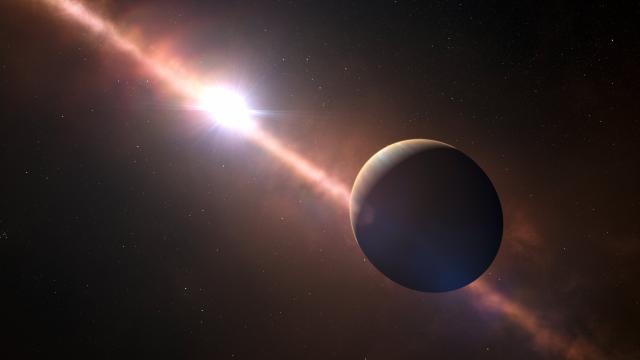Beta Pictoris b is a young exoplanet about 12 times as massive as Jupiter, with an orbit nearly twice as long. Now, a timelapse video of the planet’s nearly 23-year orbit lets you see most of that journey in just ten seconds.
Jason Wang, an astrophysicist at Northwestern University, has led an effort to condense 17 years of data chronicling Beta pictoris b’s orbit around its host star into a 10-second video of the planet’s transit. The timelapse captures about 75% of the exoplanet’s complete orbit. “We’re almost there. Patience is key,” Wang said in a Northwestern release.
Beta Pictoris b sits about 63 light-years from Earth in its namesake constellation, Pictor. The planet’s star system is relatively young—around 26 million years old. Beta pictoris b is about 8 times as far from its star as the Earth is from the Sun, according to Britannica.

The host star is 1.75 times the mass of the Sun and 8.7 times more luminous, according to the Northwestern release. Like its star (though not to the same extent, for obvious reasons), the exoplanet is “extremely bright,” Wang said. “That’s why it’s one of the first exoplanets to ever be discovered and directly imaged. It’s so big that it’s at the boundary of a planet and a brown dwarf, which are more massive than planets.”
The planet was imaged by three instruments, one at the Gemini Observatory and two at the European Southern Observatory. Malachi Noel, a high schooler in Illinois, worked under Wang to process the image data and apply motion interpolation to it, smoothing the motion of the planet over the course of its orbit. Wang corrected for image blurring using a technique called adaptive optics, which mitigates atmospheric disturbance.
In the middle of the video, Beta Pictoris b is represented by an X, because the glaring brightness of its host star blinded imaging instruments to the transiting exoplanet.
“Something like a movie — that you can see with your own eyes — gives a visceral kind of appreciation for physics that you wouldn’t gain from just looking at plots on a graph,” Wang said.

Earlier this year, Wang produced a 12-year timelapse of four stars in a different system orbiting their host star. That system, HR8799, sits about 133.3 light-years from Earth and was the first extrasolar planetary system to be directly imaged. The video of the exoplanets’ orbits shows how different worlds orbit their star at different rates, in a mesmerizing 4.5-second loop.
We’re in a critical moment for the study of exoplanets. The National Academies of Sciences, Engineering, and Medicine stated in its 2021 decadal survey that finding habitable worlds is a priority through 2030. And while the Webb Space Telescope is offering remarkably sharp views of exoplanets, clueing planetary scientists into the makeup of their atmospheres and their abundance, NASA has already outlined plans for its next-generation Habitable Worlds Observatory, which will specifically look for…you guessed it.
But we’re getting ahead of ourselves. For now, bask in the peaceful movement of the heavenly body circling Beta Pictoris.
